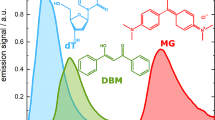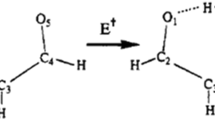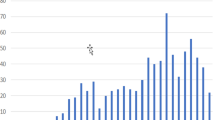Conclusions
-
1.
The rates of triplet quenching of anthraquinone by substituted anilines and phenols and their OH- and NH2-deuterated analogs have been measured by pulse photolysis in toluene and acetonitrile solutions.
-
2.
In the case of anilines the kinetics of hydrogen atom transfer are determined by charge transfer in the transition state or by the formation of charge transfer complexes as intermediates in these reactions. The kinetic isotope effect for these reactions is increased up to five as the anthraquinone triplet quenching rate constants are decreased as a function of reduced electron-donating ability of substituted anilines.
-
3.
The kinetic isotope effect for hydrogen atom transfer reactions from substituted phenols to the triplet state of anthraquinone reaches a maximum of two and is determined not only by the degree of charge transfer in the transition state but also by the kinetics of formation of an intermediate hydrogen-bonded complex.
Similar content being viewed by others
Literature cited
P. P. Levin and V. A. Kuz'min, Usp. Khim.,56, 527 (1987).
S. G. Cohen, A. Parola, and G. H. Parsons, Chem. Rev.,73, 141 (1973).
N. Ikeda, H. Miyasaka, T. Okada, and N. Matsga, J. Am. Chem. Soc.,105, 5206 (1983).
P. P. Levin, T. A. Kokrashvili, and V. A. Kuz'min, Izv. Akad. Nauk SSSR, Ser. Khim., 1265 (1984).
P. P. Levin, T. A. Kokrashvili, and V. A. Kuz'min, Khim. Fiz., 175 (1983).
S. Inbar, H. Linschitz, and S. G. Cohen, J. Am. Chem. Soc.,103, 1048 (1981).
P. K. Das, M. V. Encinas, and J. C. Scaiano, J. Am. Chem. Soc.,103, 4154 (1981).
A. B. Lutskii, Yu. I. Beilis, and V. I. Fedorchenko, Zh. Obshch. Khim.,42, 2535 (1972).
A. B. Lutskii, Yu. I. Beilis, and V. I. Fedorchenko, Zh. Obshch. Khim.,43, 101 (1973).
G. V. Sandul, V. S. Kuts, and V. D. Pokhodenko, Teor. Iksp. Khim.,5, 658 (1977).
N. D. Sokolov (ed.), The Hydrogen Bond [in Russian], Nauka, Moscow (1981).
G. D. Burfoot, E. F. Caldin, and H. Goodman, J. Chem. Soc., Faraday Trans.,1, 105 (1974).
L. Melander and W. Saunders, Reaction Rates for Isotopic Molecules [Russian translation], Mir, Moscow (1983).
R. W. Hoffmann, Mechanisms of Organic Reactions [Russian translation], Khimiya, Moscow (1979).
H. Yamataka, S. Nagase, T. Anda, and T. Hanafuza, J. Am. Chem. Soc.,108, 601 (1986).
Author information
Authors and Affiliations
Additional information
Translated from Izvestiya Akademii Nauk SSSR, Seriya Khimicheskaya, No. 5, pp. 1007–1011, May, 1988.
Rights and permissions
About this article
Cite this article
Belyaev, A.B., Kuz'min, V.A. & Levin, P.P. Kinetic isotope effect for hydrogen atom transfer from substituted anilines and phenols to the triplet state of anthraquinone. Russ Chem Bull 37, 877–881 (1988). https://doi.org/10.1007/BF00957050
Received:
Issue Date:
DOI: https://doi.org/10.1007/BF00957050




